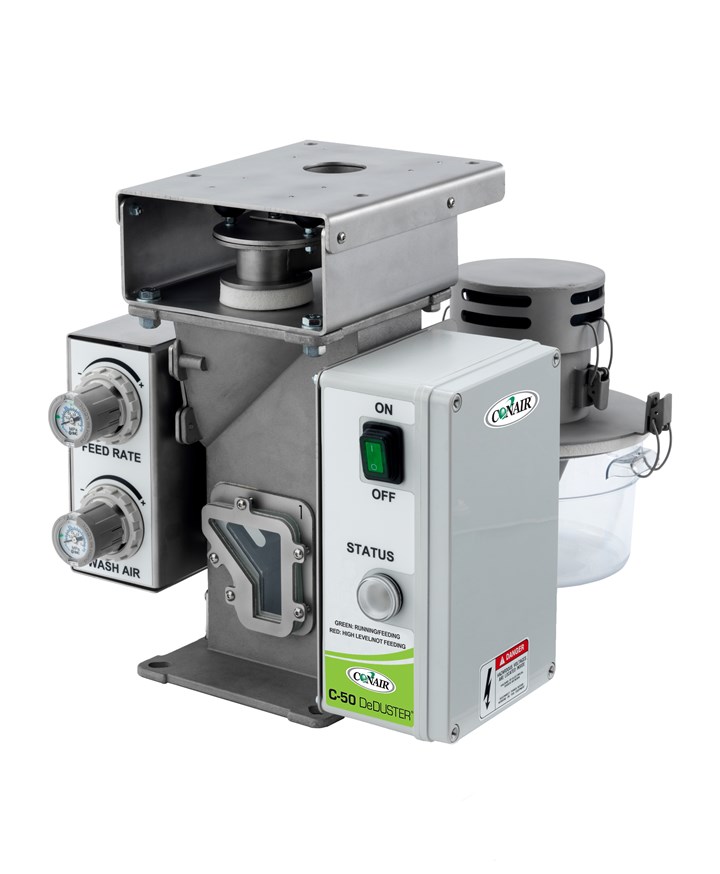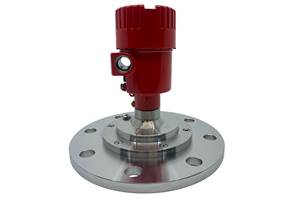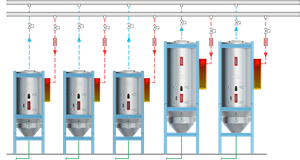Mini Deduster Redesigned, Simplified
Moving parts eliminated, built-in level sensor added.
Conair has simplified operation of its DeDuster C-50 separator, eliminated wear-prone moving parts, and improved processing of regrind, which can be very dusty. The system, which nominally processes up to 50 lb/hr is used to remove lightweight dust, angel hair and streamers from otherwise high-quality pelletized feedstock and regrind being fed to plastics processing machines. If not removed, dust and other lightweight fractions can cause cosmetic problems in molded or extruded products, including haziness, gels and black spots, as well as mechanical flaws and housekeeping problems.
Major design improvements include an adjustable, pneumatically driven vibratory feeder that replaces a paddle-style metering device, which was prone to wear, and which had occasional problems feeding regrind. With the vibratory feeder, regrind flows smoothly and there are no moving parts in contact with the material and, thus, no chance of wear. The feed rate is adjusted via a knob that regulates pneumatic pressure driving the vibrating tray.
Designers also created a wider opening through which solids flow inside of the DeDuster. The previous smaller opening was prone to bridging with regrind particles even as small as ¼ inch. Now, with the larger opening, the DeDuster can typically process regrinds up to 3/8 inch (9.5 mm).
The other enhancement is a built-in level sensor that shuts off the feeder when the hopper below is nearly full. This is important because the DeDuster cannot operate in a flood-feed condition. With the previous generation of the product, users needed to know the precise volume of the hopper and demand of the processing machine and then manually adjust feed rates to prevent over-filling.
The Conair DeDuster C50 commonly achieves residual dust content of fewer than 50 ppm for fines smaller than 500 micron and 100% streamer removal. It is extremely lightweight, weighing just 40 lb and requires only 13.25 in. of additional headroom above the feedthroat of the molding machine or extruder and loading or drying hoppers. It features stainless steel construction, 110 or 220 V operation and only consumes 7 CFM (12 m3/h) compressed air at 90 psi (6.1 bar) pressure.

Once mounted on the processing machine, the unit requires only a single-phase AC power connection and tubing connected to plant compressed air. A simple on/off switch starts the unit and feed rate is set with a rotary knob. Another knob can be used to adjust the desired level of dust removal.
As raw material enters the unit from a standard hopper loader or receiver, the vibratory tray regulates the flow into the dedusting chamber. The compressed air is introduced directly from the plant-air system and split into three streams. The first drives the vibrating table, while a second stream passes through an ionizer before entering the body of the DeDuster where it creates turbulence and breaks the electrostatic bond between pellets and the dust/angel hair. As the heavier, clean pellets continue through the feedthroat into the processing machine, the third air stream passes through a venturi and draws the lighter contaminants into a mini-cyclone so that they fall out of suspension and into a clear catch bin. The air is exhausted through a filtered outlet.
Related Content
AI Comes to Resin Conveying with Conair Technology
This patented technology automatically detects source-to-destination conditions and autonomously adjusts the conveying system in real-time to move material under optimal conditions.
Read MoreNew Pump Rewrites Conveying Rules
NPE2024: Smart Pump technology brings more flexibility and finesse to resin conveying.
Read MoreRadar Level Sensor Streamlines Bulk Material Inventory Management
NPE2024: The NCR-86 is designed to ensure rapid data updates, enhancing efficiency in inventory management.
Read MoreHow to Effectively Reduce Costs with Smart Auxiliaries Technology
As drying, blending and conveying technologies grow more sophisticated, they offer processors great opportunities to reduce cost through better energy efficiency, smaller equipment footprints, reduced scrap and quicker changeovers. Increased throughput and better utilization of primary processing equipment and manpower are the results.
Read MoreRead Next
Lead the Conversation, Change the Conversation
Coverage of single-use plastics can be both misleading and demoralizing. Here are 10 tips for changing the perception of the plastics industry at your company and in your community.
Read MoreSee Recyclers Close the Loop on Trade Show Production Scrap at NPE2024
A collaboration between show organizer PLASTICS, recycler CPR and size reduction experts WEIMA and Conair recovered and recycled all production scrap at NPE2024.
Read MoreMaking the Circular Economy a Reality
Driven by brand owner demands and new worldwide legislation, the entire supply chain is working toward the shift to circularity, with some evidence the circular economy has already begun.
Read More













